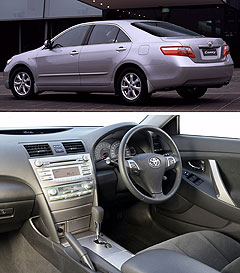News - Toyota - CamryCamry E-tagsEverything you wanted to know about Toyota's new Camry but were too afraid to ask1 Aug 2006 Hybrid hopes A HYBRID Camry is still some years away, according to Toyota Australia chairman John Conomos. Although buoyed by interest in hybrids, and the availability of a Camry hybrid in the United States, Mr Conomos believes Toyota would need a minimum number of 30,000 a year locally to justify the cost, with a price premium of just 10 per cent over the base model. It looks like a Camry hybrid sold in Australia will have to wait for the next-generation car, which is due in 2010/11. TRD options DON’T bank on a TRD Camry just yet. Toyota marketing chief David Buttner reckons a Camry built by Toyota’s new TRD sports division is possible but he is concerned it may be too close to the confirmed TRD Aurion in specification and market appeal. Toyota plans to launch a TRD version of the HiLux ute and, GoAuto understands, has three more options for other TRD product, including a Corolla based on next year’s new-generation model. Local content THE new Camry is a global car with interchangeable parts. Toyota Australia’s local designers wanted to put greater design differentiation into the car to make it more "Australian" than the car available in other markets, but Japan put its foot down when Toyota Australia proposed changing the front end to make it crisper, as well as making the headlights bigger. Local content in the Camry has also dropped slightly but it is still quite high by local standards. PBR and Hella developed the brakes and headlights in Australia.  The right tune The right tuneTOYOTA Australia’s suspension calibrations for the Camry, which were developed for Australian conditions, have been taken up by Thailand and the United States. It is the first time the local suspension tune has been used in a Camry built abroad. Two suspension tunes are available locally. The Altise, Ateva and Grande use a normal tune while the Sportivo gains a firmer-riding, sports calibration. The Camry sports model in the US is called the SE, which not only uses the Australian-inspired Sportivo suspension but also the locally developed bodykit, which proved a hit on the previous model. Middle East-bound Camrys use the Australian suspension. F1 influence IT MAY be a family sedan, but the sixth-generation Camry’s aerodynamics have benefited from Toyota’s Formula One motoring racing campaign. Among the slippery innovations used is a stepped underbody cover, which is designed to help maximise downforce on the front of the vehicle. This creates a venturi effect and hence a low-pressure area under the front end to increase downforce. Toyota claims the underbody aerodynamics make an important contribution to its lower drag coefficient, which is now down to 0.28Cd. Apart from the underbody cover, the Camry has also benefited from a new stepped engine undercover and fairings for the rear wheels that direct airflow around the tyres and hence reduce drag. Reflecting its performance orientation, the Sportivo models gains extra rear floor and fuel tank undercovers to also increase downforce at the rear end of the car. Robots, people BUILDING the new Camry has become more automated. The Altona factory’s automated body line has risen from 52 per cent for the previous model to 72 per cent. More than 240 welding robots are employed on the global body line, compared with 104 on the old line. But despite more robots, Toyota has expanded its factory workforce. Virtual assembly line TOYOTA created a "virtual assembly line" on computer to build the Camry in order to reveal potential production problems well before trial build was started. According to Camry chief engineer John Bell, this eliminated any potential hiccups in the system. The Camry was also the first "non-prototype" Toyota. It was the first time such new technology had been applied to a Toyota built outside Japan. "Our first confirmation vehicles were built with production tooling," he said. "Our first Australian trial car was built on-line. Even for the first Australian trial vehicle the process went so smoothly that at the end of the assembly line we started it and drove it off the line."Half a million I4 sales TOYOTA expects to sell its 500,000th Australian-made four-cylinder Camry on the Aussie market some time next year. The four-cylinder Camry has been Australia’s dominant medium passenger motor vehicle virtually from the time it was first built in Melbourne in 1987. It has averaged 23,500 sales a year since 1991. The Camry four has been number one in the medium market for the past 12 years. |
Click to shareToyota articlesResearch Toyota Camry pricing
Motor industry news |














Facebook Twitter Instagram